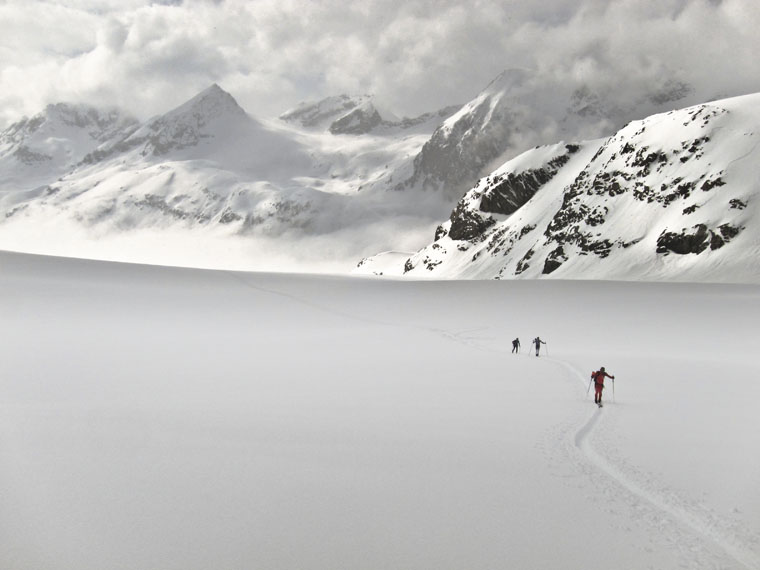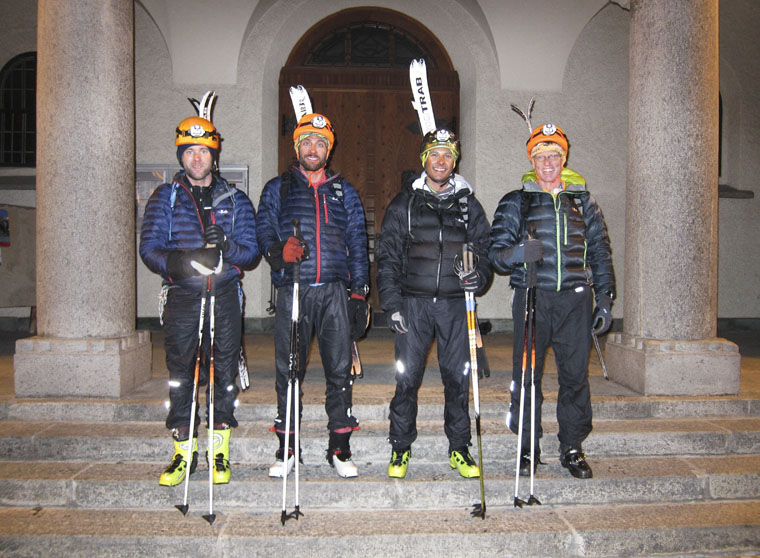Skiing the Haute Route in a day (well, almost)


The 120km journey from Chamonix to Zermatt was pioneered in summer by members of the Alpine Club. Initially called ‘the High Level Route’ in English, it became known as ‘the Haute Route’ after it was first completed on skis in 1911. The French name may have stuck, but the Brits and British guides continue to make their mark on this route. Peter Cliff wrote the first decent guidebook in English; Nigel Shepherd has made the journey over 50 times; and now another crossing stands out: that of a GB team in a single push.
I suspect you didn’t know we had a British Ski Mountaineering team, or did you? They are pretty handy at it as well. Being mountain folk at heart, and a couple of them working as mountain guides, all that training and racing was ideal preparation for what would turn out to be the most epic feat of their lives. After a blistering race season, Jon Morgan “earmarked two weeks for a crack at one of my lifetime objectives – Chamonix to Zermatt on skis in a single push.”
And so it was that the team – Jon, Misha Gopaul, Ben Tibbetts and Ben Bardsley – assembled at Chamonix church at 2pm on Tuesday 2 April. They had some simple self-imposed rules: no road transport or lifts; from Chamonix church to Zermatt church via the proper Haute Route.

It had only ever been done three times, and always by top French racers. The forecasts suggested that winds would be light with minimal precipitation, with a chance of fog overnight. A call to the guardian of the Valsorey Hut confirmed that a track had recently gone over the Plateau du Couloir (a serious crux section of the classic traverse) so having ordered 12 litres of sweet tea and risotto for four, they set off. Jon Morgan picks up the tale…
“We must have looked slightly mad running in ski boots through central Chamonix with skis on our backs, but Ben Tibbetts set a cracking pace and soon we were skinning up the Balcon Nord track to Lognan. We picked up our glacier kit and took 4h 20 to get from Chamonix church to the Col du Chardonnet.”
With a rope in place at the col, and a track heading towards the Grand Lui, the team were flying. The category-three avalanche forecast, especially on NE to NW facing slopes, forced the team to spread out up the steep slope to the Col de Grand Lui.
“It didn’t feel too dodgy as I broke trail up the 40° slope. Then it started to feel a bit hollow underfoot… whuuuumph! The snow bridge collapsed and a crevasse opened up a third of the way along my skis. Ah, that’s what the hollow feeling was! About 50m to one side it passed OK and before long I was breaking through to neve and cramponning up to the ridge at 3500m at dusk.”
One of the joys of skiing the Haute Route is timing the descents to get the snow in the best condition for the best skiing. On a trip like this the team did not have that luxury, and had to take every slope as they found it. Add to this the fact they were on lightweight SkiMo kit (164cm long skis, 65mm underfoot) and it was bound to get tricky at times…
“I first did the Haute Route in 1997 and from this col we had skied down amazing spring snow at midday to La Fouly. But now, after a refreeze, we had a combination of breakable crust and fog. Descending 2000m in the dark on bad snow felt like a long way. On the plus side, we all had powerful Petzl Nao torches, so we could see the enemy. On the down side, Ben T’s boots didn’t seem to fit any more. He looked briefly unsure about the prospect of many more hours of suffering. FOMO ensured he ignored the pain.”
After a big refuel at the hamlet of La Fouly, they continued up to Ferret, then over Combe des Planards. Nice powder then hard-pack took them to Bourg St Pierre, and their Rab Microlight jackets made the chilly night bearable. The long skin to the Valsorey hut is arduous at the best of times, and sounded like the low point for some members in the team. But at 7am they were greeted with a stunning dawn, looking back to the Mont Blanc massif, and a friendly welcome from the guardian.
Jon was in good spirits: “We took ages to eat our risotto – delicious but portion size not appropriate to objective size. Then we tucked into rösti with egg and lots of sweet tea. Misha quietly died for 10 minutes on a bench, and we all swallowed painkillers/changed socks/repaired feet. Ben T’s didn’t look pretty.”

Eighteen hours had elapsed. The pace was not what Jon had hoped for – at this speed they wouldn’t make it before night two. With cloud/fog forecast that wasn’t going to work on Zermatt’s Stockli glacier. Packs were also heavier now as they carried enough water to get to Zermatt (three days’ travel at normal client speed). Time to get moving again.
“Brilliant sunshine, inversion and a great track to follow – everyone felt better once the breakfast and painkillers had kicked in. Misha awoke a different man (what pills did HE take?!). He stormed up to Plateau du Couloir with Ben T out front. What a view – the dramatic scenery of the Grand Combin looking out on the whole of the Alps: back to the Mont Blanc Massif; onwards to the Valais; and Italian peaks across the horizon. Group photo? No, let’s hurry. We still have a huge distance and 2500m of vertical to cover. The second night was not an appealing prospect.”
Skinning up in the full heat of the afternoon sun was a very real prospect, but the team were lucky: intermittent cloud saved them from meltdown on the Otemma glacier. But flat light and sleep deprivation played some funky tricks on their minds. Ben Bardsley reports: “Boulders turned into huts and groups of people appeared in the distance. But we were all alone in the wilderness”.
The huge Otemma glacier curls from the Chanrion hut to the Vignettes. Past Haute Routers will know it as the tedious flat bit after the Vignettes hut. I cannot imagine how it would drag on after 29 hours on the go.
“It was frustrating hardly to notice the horizon change as hours went by,” says Jon. “Then fog enveloped us and we had to use navigational devices and techniques to find Col l’Evêque, losing time. If we couldn’t get over the col, a descent to Arolla – quitting our mission – was likely. We dropped out of the fog at 6pm by Mt Brûlé. The fog didn’t look promising and I didn’t fancy the Stockli glacier with no vision – what to do?”

The pressure to continue was impossible to ignore, so the team pressed on. They had slowed and were ascending at 600m per hour (most amateur enthusiasts would average 300 to 350m of ascent per hour – and only for a few hours). Even after more than 24 hours the team felt 600 was a bit on the slow side…
They reached Col Valpelline at 8pm at dusk, in fog. With no tracks to follow, this was a critical moment. Before them was a complex glacial descent that twists a contorted journey through major slots with serious threat from all angles. But Jon knew the way from many descents, so on they went. “We pushed on into the impending gloom,” says Ben Bardsley. “Then at the col the cloud miraculously lifted to show our descent in full glory. The setting sun lit up the surrounding giants and we sped on in fading light.”
Soon, the glacier gives way to the long and featureless (but thankfully speedy) traverse under the north face of the Matterhorn, and at just after 9pm the team finally arrived in Zermatt after 31 hours and 22 minutes. Jon was typically understated: “We persuaded a Taiwanese tourist to take our photo outside Zermatt church. Then we had beer and pizza – it sure tasted good.” FL
Words: Martin Chester and Jon Morgan
Photos: Jon Morgan